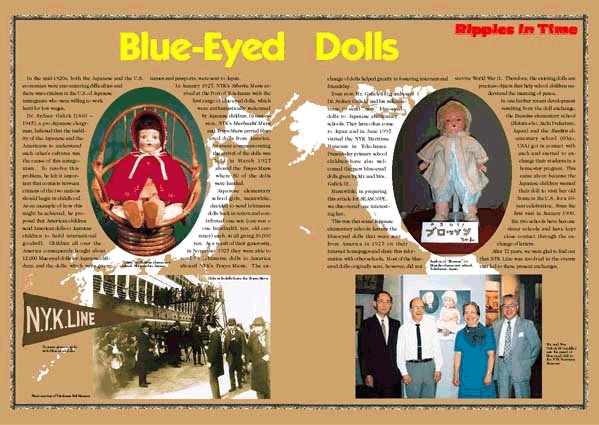
(株)日本郵船機関誌「SEASCOPE」より,以下の画像および文章のご提供いただきました。

Blue-Eyed Dolls
In the mid-1920s, both the Japanese and the U.S. economies were encountering
difficulties and there was criticism in the U.S. of Japanese immigrants who
were willing to work hard for low wages.
Dr. Sydney Gulick (1860 - 1945), a pro-Japanese clergyman, believed that the
inability of the Japanese and the Americans to understand each other's
cultures was the cause of this antagonism. To resolve this problem, he felt
it important that contacts between citizens of the two nations should begin
in childhood. As an example of how this might be achieved, he proposed that
American children send American dolls to Japanese children to build
international goodwill. Children all over the America consequently bought
about 12,000 blue-eyed dolls for Japanese children, and the dolls, which
were given names and passports, were sent to Japan.
In January 1927, NYK's Siberia Maru arrived at the Port of Yokohama with the
first cargo of blue-eyed dolls, which were enthusiastically welcomed by
Japanese children. In succession, NYK's Maebashi Maru and Tenyo Maru carried
blue-eyed dolls from America. An event commemorating the arrival of the
dolls was held in March 1927 aboard the Tenyo Maru where 50 of the dolls
were handed.
Japanese elementary school girls, meanwhile, decided to send Ichimatsu dolls
back in return and contributed one sen (one sen = one hundredth yen, old
currency) each, in all giving 30,000 yen. As a result of their generosity,
in November 1927 they were able to send 58 Ichimatsu dolls to America aboard
NYK's Tenyo Maru. The exchange of dolls helped greatly in fostering
international friendship.
Even now, Mr. Gulick III (grandson of Dr. Sydney Gulick) and his wife
continue to send "new" blue-eyed dolls to Japanese elementary schools. They
have often come to Japan and in June 1997 visited the NYK Maritime Museum in
Yokohama. Present-day primary school children have also welcomed the new
blue-eyed dolls given by Mr. and Mrs. Gulick III.
Meanwhile, in preparing this article for SEASCOPE, we discovered one
interesting fact.
This was that some Japanese elementary schools feature the blue-eyed dolls
that were sent from America in 1927 on their Internet homepages and share
this information with other schools. Most of the blue-eyed dolls originally
sent, however, did not survive World War II. Therefore, the existing dolls
are precious objects that help school children understand the meaning of
peace.
In one further recent development resulting from the doll exchange, the
Damine elementary school (Shitara-cho, Aichi Prefecture, Japan) and the
Ruskin elementary school (Ohio, USA) got in contact with each and started to
exchange their students in a home stay program. This came about because the
Japanese children wanted their doll to visit her old home in the U.S., for a
60-year celebration. Since the first visit in January 1990, the two schools
have become sister schools and have kept close contact through the exchange
of letters.
After 72 years, we were glad to find out that NYK Line was involved in the
events that led to these present exchanges.
Photo captions
"Grace" in Damine elementary school, Shitara-cho, Japan
Pennant given to girls with blue-eyed dolls
Photo courtesy of Yokohama Doll Museum
Replica of "Blossom" in Honcho elementary school, Yokohama, Japan
Mr. and Mrs. Gulick III (middle) saw the panel of blue-eyed doll in the NYK
Maritime Museum